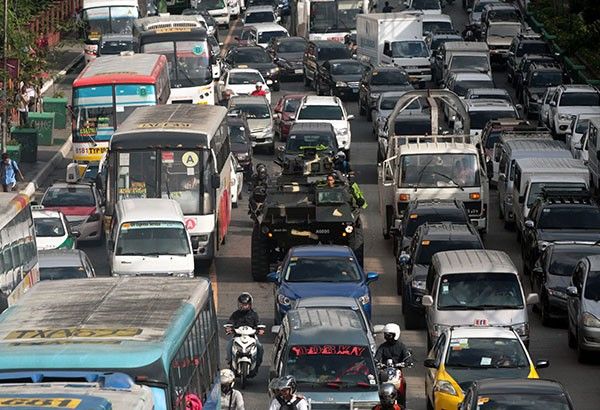Commentary: What's taking so long? Philippines’ infrastructure challenge
April 14, 2017 | 5:00pm

Despite posting some of Asia’s highest rates of economic growth, the Philippines only ranked 95th in Infrastructure in the 2016 Global Competitiveness Report.
Kriz John Rosales/File
MANILA, Philippines — During Holy Week, many Filipinos will find ourselves traveling to be with family and friends.
Whether we go by road, sea, or air, we will easily find ourselves part of a crushing crowd of people pushing the country’s infrastructure to its limits.
Holy Week travel might be easier if the Philippines had better infrastructure—so what’s keeping the country behind?
Despite posting some of Asia’s highest rates of economic growth, the Philippines only ranked 95th in Infrastructure in the 2016 Global Competitiveness Report.
Lagging behind most Association of Southeast Asian Nations (ASEAN) counterparts, the country’s infrastructure is disproportionately concentrated in major urban centers such as Metro Manila, Calabarzon and Central Luzon.
Lagging behind most Association of Southeast Asian Nations (ASEAN) counterparts, the country’s infrastructure is disproportionately concentrated in major urban centers such as Metro Manila, Calabarzon and Central Luzon.
For a long time, underinvestment in infrastructure could be explained by the lack of fiscal space. Yet, even under better fiscal conditions, the previous government was beset with underspending.
Addressing institutional weaknesses
In an ADRi Special Study entitled “Infrastructure and Economic Growth: The Philippine Experience,” Dr. Epictetus Patalinghug examines the country’s infrastructure situation.
President Rodrigo Duterte’s infrastructure-building campaign is the centerpiece of his economic agenda.
The administration seeks to increase infrastructure spending from 5.4percent of GDP in President Duterte’s first year in office to 7.1 percent by the end of his term.
In its first National Economic and Development Authority (NEDA) Board meeting in September, the government already approved nine projects worth P171 billion. During the second NEDA Board meeting in November, seven projects worth P270 billion were also approved.
In 2016, there was a 42.8 percent increase in infrastructure spending.
While these are positive developments, 7.5 percent of the budget was unutilized, in part because of the lack of absorptive capacity. Duterte’s team has yet to address long-standing issues in its project planning, implementing and monitoring agencies.
Key agencies should adopt a long-term infrastructure planning framework. A national masterplan would be crafted, which would identify the country’s priority infrastructure projects. An independent body could decide which projects to implement. This would de-politicize the public investment assessment and decision-making processes.
Since the legislative budgeting process is conducted annually, funding predictability is only possible for the short-to-medium term through budget ceilings. These ceilings and may not withstand changes in administration. Instead, long-term planning can be linked with the medium-term budget framework. This can be strengthened by making long-term budget commitments for large investment projects.
Hybrid PPPs
In July 2016, Department of Budget and Management Secretary Benjamin Diokno proposed a “hybrid” Public-Private Partnership (PPP) scheme, which lets the government build, while the private proponent operates and maintains the project. Dr. Patalinghug notes that pursuing a hybrid PPP might be a more preferable option, since the government has the comparative advantage of “build,” and will be better-equipped in addressing Right-of-Way (ROW) issues.
Once completed, the project will be transferred to the private proponent, which is better-suited to maintain, operate and market the project. A hybrid PPP will also guarantee that projects are built
based on the government's infrastructure plan and reduce unsolicited proposals that are more oriented towards profitability, rather than connectivity.
The PPP program was popularized under the Aquino administration to fund large-scale infrastructure programs. At the end of his term, however, 12 projects were awarded but only 3 were completed. Delays were partly caused by weaknesses in the Build Operate Transfer (BOT) Law and institutional limitations.
Compared to traditional modes of procurement, PPPs could be advantageous since developers could internalize cost savings by bundling project development, operations, and maintenance. Dr. Patalinghug, however, reasons that internalization could also be undesirable because of developer risk aversion.
Ultimately, to sustain economic growth and improve our citizens’ quality of life, the government should continue to prioritize infrastructure development. While the target of government infrastructure spending has already reached the recommended level, the lingering issues delaying implementation have to be addressed. At this stage, it’s not about the money, it’s about the pace of execution.
Dindo Manhit is the president of think tank Stratbase Albert del Rosario Institute, a partner of Philstar.com.
BrandSpace Articles
<
>
Philstar
- Latest
Latest
Latest
December 14, 2024 - 5:58pm
By Jing Castañeda | December 14, 2024 - 5:58pm
December 14, 2024 - 11:22am
By Karry Sison | December 14, 2024 - 11:22am
December 9, 2024 - 2:53pm
By Rupert Paul Manhit | December 9, 2024 - 2:53pm
December 8, 2024 - 9:00am
By Jing Castañeda | December 8, 2024 - 9:00am
November 30, 2024 - 5:19pm
By Joanna Perfecto | November 30, 2024 - 5:19pm
November 23, 2024 - 6:23pm
By Rupert Paul Manhit | November 23, 2024 - 6:23pm
Recommended





























